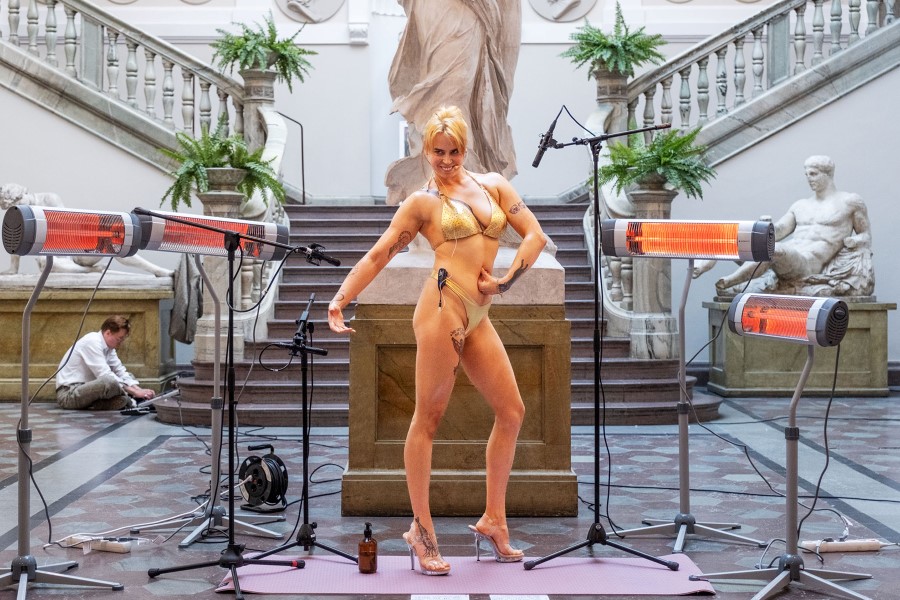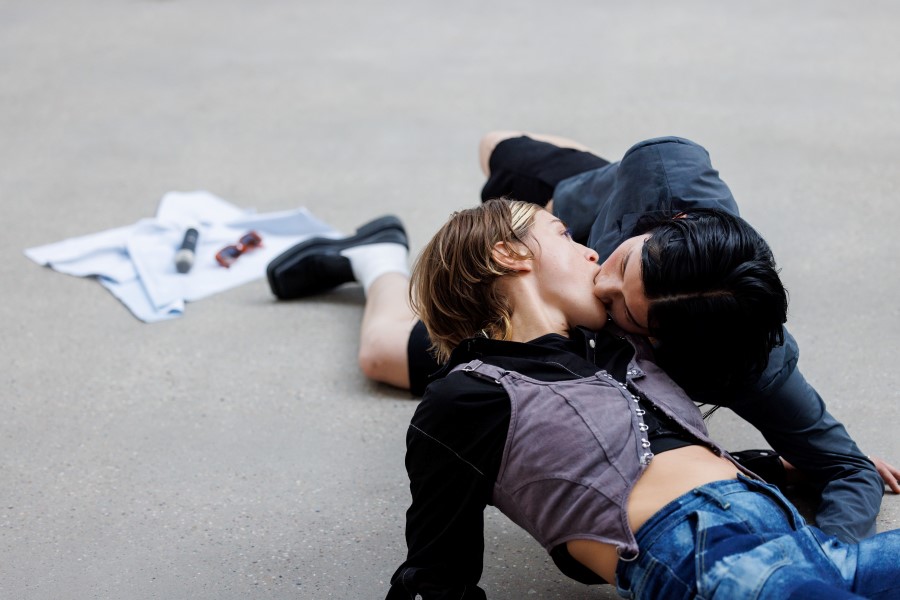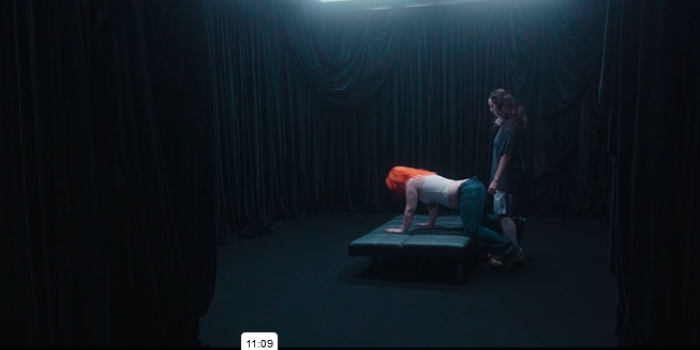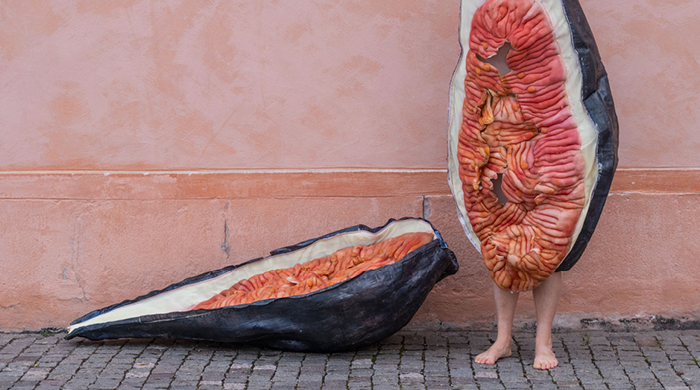Performances 24 May
Louis Schou-Hansen – Tragedy
- Time: 14.00-17.00
- Location: Uppsala Art Museum, floor 1
- Language: English
You may come and go as you wish in the performance installation.
About the artwork:
Tragedy is an all-consuming space, where two miserable fictional characters enact a slow, endlessly looping nightmare. This dreamscape takes the shape of an entrapment, a labyrinth without walls, a site where Western cultural tropes from the baroque until now take shape as disordered compulsions: lap dances, star-crossed lovers, cowboy fantasies, dying swans, court des ballets, still lives, and Hollywood sex. Tragedy is a non-emotional burial ground for an undying history—a form of time in decay.
In 2019, artist and theorist Alina Popa wrote in one of her final essays, “The body is real, but what we think about it is fiction.” While alluding to the “real” as the material properties of the body, such as flesh, bones, blood, skin, etc. Popa also points to the body as a disciplined container where complex fictional realities are cultivated until they penetrate our skin and stick to our flesh as something true. Drawing on an expanded interpretation of Popa’s 2019 quote, Tragedy explores the body and its surroundings as a complex network of destructive Western fictions where all of us become violent agents of a dying world.
Credit:
PERFORMANCE, SOUND AND COSTUMES: Louis Schou-Hansen
PERFORMERS: Thjerza Balaj & Elise Nohr Nystad
TEXTILE WORK: Karoline Bakken Lund
PHOTO: Chai Saedi
OUTSIDE EYE: Alexandra Tveit
TRAILER/DOCUMENTATION: Chris Helberg
FUNDED BY: Arts Council Norway and PAHN – Performing Arts Hub Norway
CO-PRODUCTION: Podum Oslo
Corpus Cosmos – introductory guided tour
Join us on a guided tour of the exhibition Corpus Cosmos – an exhibition about the body, cosmos and our place in the world. During a 20-minute guided tour, you will get insight into the exhibition's central themes and artists, and an introduction to how the works are connected.
- Times: 14.30 and 15.30
- Place: Uppsala Art Museum, floor 3
- Language: Swedish
Free entry. Drop-in subject to availability.
About the exhibition
Corpus Cosmos is a collection of art produced by artists from different parts of the world, who explore the body in different ways – as pure matter, as storytelling, and as a concept. The artworks range from sculptures and paintings to sound and installations, and revolve around questions of anatomy, science, colonial history, faith and cosmology.
Among the participating artists are Ingela Ihrman, Pakui Hardware, Pia Sandström, Camila Sposati and Xadalu Tupã Jekupé. Together, they uncover new ways to understand the relation between the body and the surrounding world.

Laia Estruch – Stray Birds / Ocells Perduts V67
What does a voice that wants to fly sound like? In this unique piece, Laia Estruch uses the voice as her primary instrument – move freely and experience performance in both stairwells and treetops. The piece will be performed twice: first at the museum, then in the Botanical Garden.
- Time: 15.00-15.30 and 17.00-17.30
- Location: Uppsala Art Museum and in the Botanical Garden (Norbyvägen 5)
About the artwork:
How many sounds can one single body harbour? The Catalan artist Laia Estruch has developed her own performative practice where the voice and breathing become an extension of the body. Ocells Perduts V67 (2021) is a sound creation and experimentation project, between sculpture and performance, in which an investigation is carried out into the body of trees and the voice of birds in relation to the human body. A proposal for research and creation, based on the capacity of our voices to travel, interact and migrate.
The idea for Ocells perduts was first sparked in early (2020) when Estruch came across a Catalan translation of Stray Birds (1916), Bengali writer Rabindranath Tagore's collection of aphoristic poems, at a second-hand bookshop in Mexico City’.

Maja Fredin – Broiler
- Time: 16.00-16.15
- Location: Uppsala Art Museum, Vasasalen / The auditorium
- Max 100 people
About the artwork:
Lately I have been thinking a lot about chickens, meat and muscles.
Fabricated chickens whose muscle growth is maximized to the extent that the legs break under their weight.
As the Broiler became the perfect metaphor for the industrializing and optimizing the self, I am forcing myself to look at the world through the lens of a bodybuilder. An investigation of the ego-centred times we live in, an era where the world is on fire, everything seems to be fake and plastic, but as a paradox authenticity and personal growth is rewarded.
I am now totally absorbed in gym training and the building of my own flesh has become my art form. The perfectly moulded antique marble statues are lingering, just like the fascist movement once glanced back to this so called “white supremacy”. Once a colourful world, stands now cold and pale in its hollow perfection.
I dream of revolution and a paradigm shift.
But what do I do instead of raising hell?
I go to the gym. Because it is easier to improve upon yourself than the world. When I lift the self becomes irrelevant, I am simply my body and my breathing. The flesh.
Concept, performance, costume and scenography: Maja Fredin
Choreography: Karin Raudsepp, Maja Fredin
Composition and sound design: Martin Seipel, Maja Fredin

Deva Schubert – Glitch Choir
- Time: 19.00-19.50
- Location: Uppsala Art Museum, Vasasalen / The auditorium,
- Max 100 people
About the artwork:
Glitch Choir transfers the phenomenon of the glitch into the analog space. At the center of the piece is the recomposition of a song of lament through glitching. Historically, public mourning has primarily been performed by women, so-called lamenters, who, in exchange for payment, give emotional expression to others’ grief for the deceased. It is mostly women, who are allowed to, but also damned to glitch the private into the public.
The two female performers open up a collective body of mourning by creating a space of intimate multiresonance. In the vocal distortion already inherent in the lament, a transformation of mourning into a collective glitch takes place. What kind of choir emerges in the dissonance of frequencies?
In the Glitch Feminism Manifesto (2013), Legacy Russel looks at the glitch as a moment of (technical) failure that manifests an interruption of information. This disturbance produces an opening of representation. Not only does something break, but something else, something new, emerges. It is a search for polyphonic moments in which the hybridity of our lived reality resounds in mournful and rebellious songs.
Concept & Choreography: Deva Schubert
Performers: Chihiro Araki and Deva Schubert
Composition and Sound design: Davide Luciani
Costume: Ama Tomberli
Production: Wiebke Wesselmann
Funded by: FONDS DARSTELLENDE KÜNSTE #Take Care



